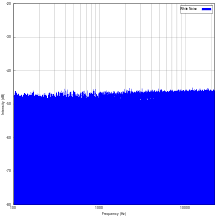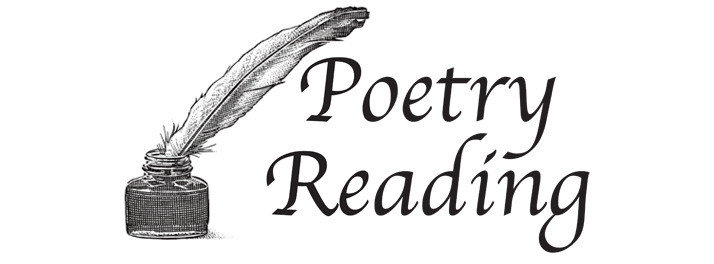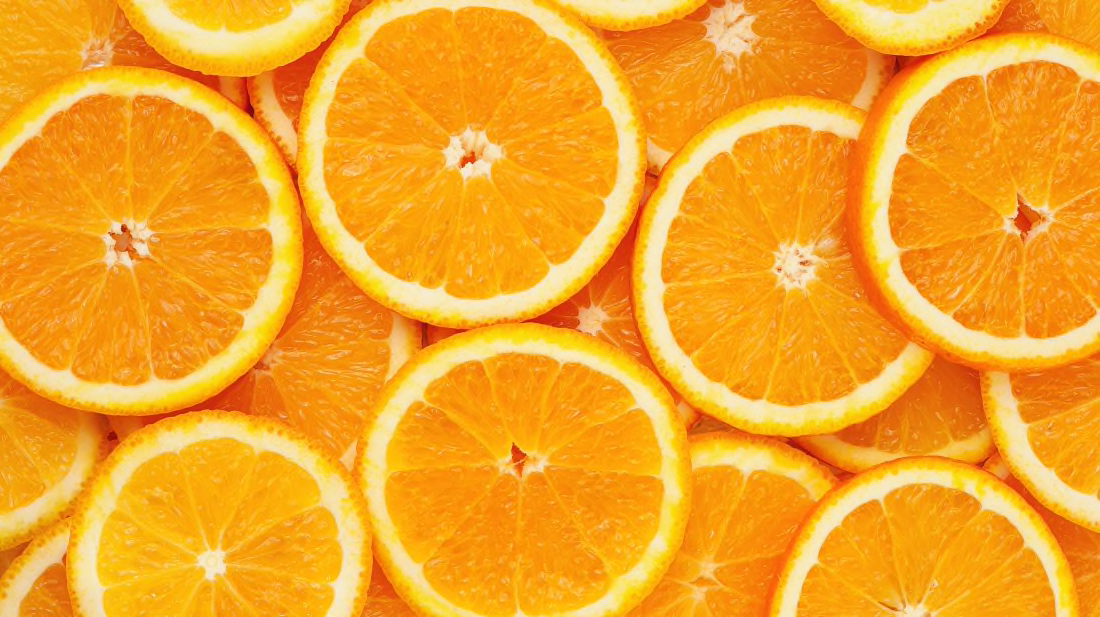Red noise helps you focus, pink noise helps you sleep, and blue noise gives you superpowers! Wait wait wait, hold on. What are you talking about? How can a simple noise change my life, and why are they colored?

The Telecommunications Glossary (it’s a Federal Standard, so you know it’s legit) formally defines 6 colors of noises. These include white, pink, brownian, blue, violet, and gray, and they’re named after their corresponding color from the same collection of frequencies in the visible light spectrum.
White noise
I’ll bet you’re all familiar with this one, the OG noise. As the first named noise, white noise, like white light, which is composed of all frequencies of visible light mixed together, is composed of all frequencies of audible noise mixed together. To us humans, that’s generally between 20 Hz and 20 kHz, and it sounds like TV static.

(A frequency vs intensity graph of white noise)
The main advertised benefit of white noise is that it masks all the random distracting noises from your surroundings. In essence, it helps you focus while you study or stay asleep while you’re sleeping. It’s claimed that if a massive truck speeds past your house in the dead of the night, its vroom vroom will be drowned out by all the frequencies already playing in your ears. But that means it basically blocks out ambient noise by overloading your system, which I personally find very unpleasant.
White noise is often confused with the hum of your hotel A/C or the drone of the large cafe, but those examples are actually where the other colors of noise come in.
Pink noise
Let’s take a look at pink noise, white noise’s twin sister. Pink noise is composed with the same idea as white noise, except that it decreases in intensity as frequency rises. To me, it sounds like an ocean, its constant, low rumble paired with the occasional high tones of breaking waves.

(A frequency vs intensity graph of pink noise)
By the words of Cleveland Clinic, “pink is the new white,” and it solves my personal issues with white noise. While most people perceive white noise as uncomfortable static, they generally hear pink noise as a more flat and even sound, still able to mask the distractions of ambient noise. If you use white noise to help you focus or fall asleep, you might want to consider upgrading to pink.
Brownian noise
Also known as red noise for its similarity to pink noise, brownian noise, or brown noise for short, decreases in intensity as frequency rises with a steeper slope than pink noise.

(A frequency vs intensity graph of brown noise)
This one is by far my favorite out of the three we’ve covered so far! Clearly, I have some sort of bias against the higher pitched spectrum of frequencies. What are your thoughts on this? Comment below!
Unlike the other 5 noise colors in this section, brownian noise is actually named after its counterpart in physics: brownian motion. Named after the Scottish botanist Robert Brown, brownian motion refers to the random motion of particles suspended in a fluid resulting from their collision with the fast-moving molecules in the fluid. How does this relate to brown noise? The orderly, y = -x + b frequency graph of brownian noise depicted above is actually the signal noise produced by brownian motion.
White noise, pink noise, and brown noise are the three musketeers of audio sleep aids. Because they cover the full spectrum of frequency, they’re perfect for masking ambient distractions. Brown noise specifically mimics the low roars of waterfalls and strong winds. If you’re a fan of rainymood.com, you’ll enjoy brownian noise.
Blue noise
Blue noise, unfortunately, does not give you superpowers. In fact, it lied to you, and it’s actually pink noise’s evil uncle! It’s weaker at the low end, and it grows stronger in intensity as frequency rises. Basically, it’s the opposite of pink noise, and it’s worse than TV static.

(A frequency vs intensity graph of blue noise)
There’s no question as to why blue noise makes little to no appearances in “The Secret to Better Sleep” and “Life Hack: Improve Your Focus” blogs; I can’t even listen to it for more than 5 seconds, but it does possess an applicable use in audio engineering. It’s used for a process called dithering, which is when noise is added to a digital recording to reduce distortion and smooth it out. Regardless, the color blue may be soothing to the eyes, but the noise of blue is anything but pleasant.
Violet noise
I may be biased against higher frequencies, but somehow violet noise doesn’t sound all that bad to me. As you’ve probably guessed from the color, violet noise is basically the opposite of brownian noise; it contains high frequencies, like violet in our visible light spectrum. Without the conflict between high and low frequencies, isolated violet noise sounds to me like the pitter-patter of a nice warm shower. I’m not saying I’d let this noise lull me to sleep, but I’d listen to it over blue or white.

(A frequency vs intensity graph of violet noise)
Gray noise
Finally, we have gray noise. According to its Wikipedia page, gray noise “is random white noise subjected to a psychoacoustic equal loudness curve (such as an inverted A-weighting curve) over a given range of frequencies, giving the listener the perception that it is equally loud at all frequencies.” This may sound trippy and overly technical, so I’ll break it down for you. Gray noise is just white noise, but upgraded to sound better to the human ear.

(A frequency vs intensity graph of gray noise)
The best way to understand gray noise is to hear it yourself, so have a listen!
Gray noise: https://www.youtube.com/watch?v=yiy69D__w5Y
I’d say that’s a pretty accurate waterfall.
The other 5: https://www.youtube.com/watch?v=3kUpS8EBtqA
Here’s a nice sample comparison between the other five colors of sound I’ve mentioned today. Comment below: What’s your favorite color of sound?
When it comes down to it, we’re all humans with varying preferences. Some of you out there might be complete weirdos who bop to blue noise on a regular basis or otherwise enjoy a late night installment of 4 minutes and 33 seconds of silence, but you do you. In the end, the most effective life hack to improve your study focus or better your sleep and life in general is to use whatever tools you’re most comfortable with. It’s all personal preference!



